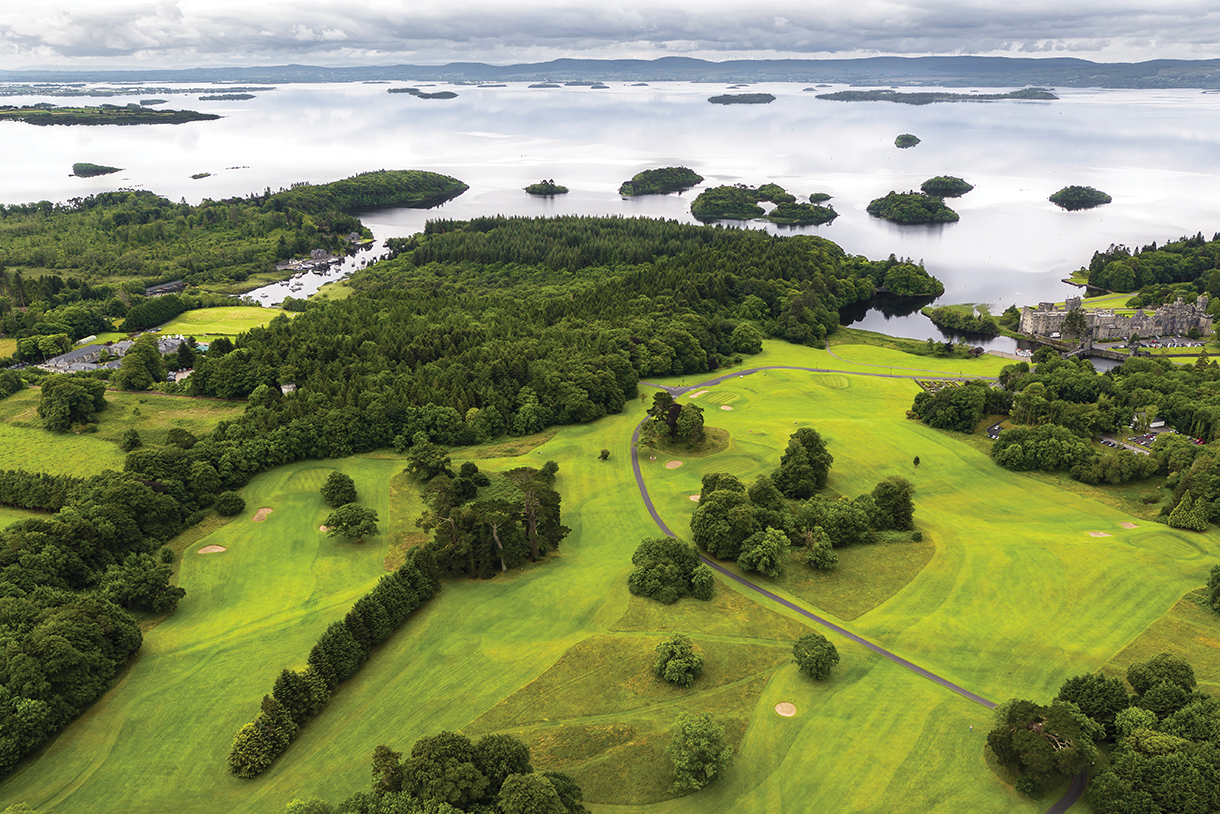
Galway, the Gaelic Kingdom
By Frank Vizard
Galway, the capital of the west of Ireland, is a place so far removed from the rest of the country that it exists like a Gaelic kingdom left to its subjects long ago by a departing ruler but carrying on splendidly nonetheless. It’s a place once on the edge of the known world that still allows a visitor to turn a back to the Atlantic Ocean and the lands beyond to contemplate the rest of Europe. It’s a place where two languages, Irish and English, mingle to produce everything from an evening of splendid theater written by native playwrights to a night of brilliant craic (Irish for “a good time”) driven by engaging conversation down at the local pub.
The city of Galway, in the county of the same name, sits at one end of Lough Corrib, the second-largest lake in Ireland, a gatekeeper to a sliver of river that connects the lake to the sea. But perhaps the best introduction to Galway and its environs is at the other end of the lake. If a kingdom has a castle at its center, then the gray-stoned stronghold that rules the west of Ireland is called Ashford.
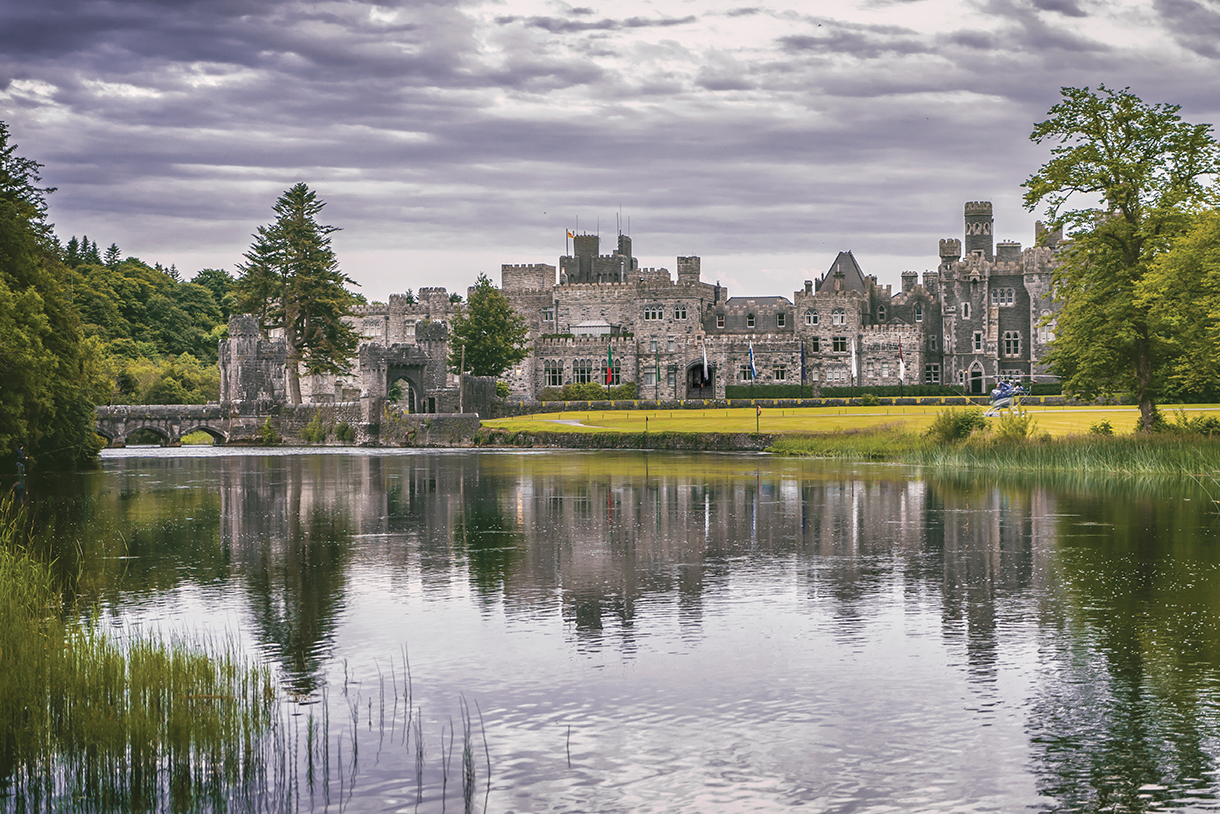
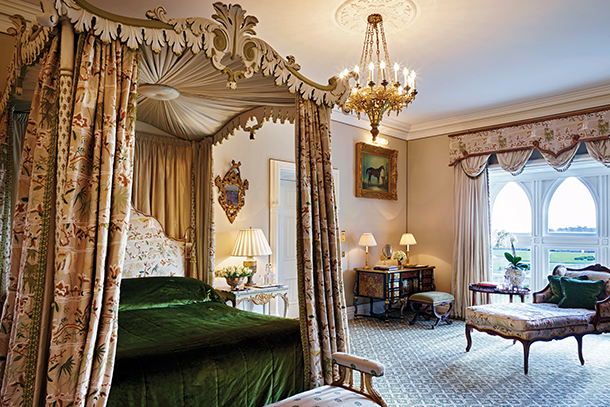
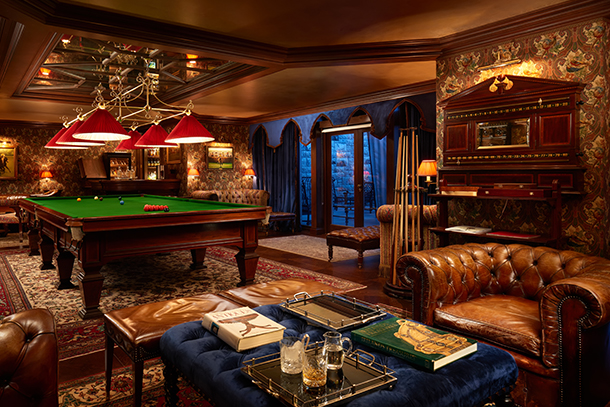
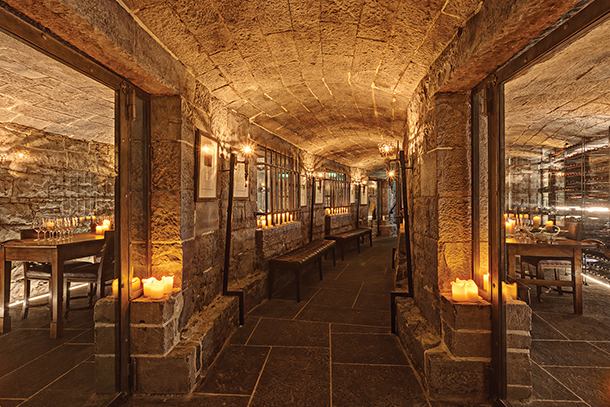
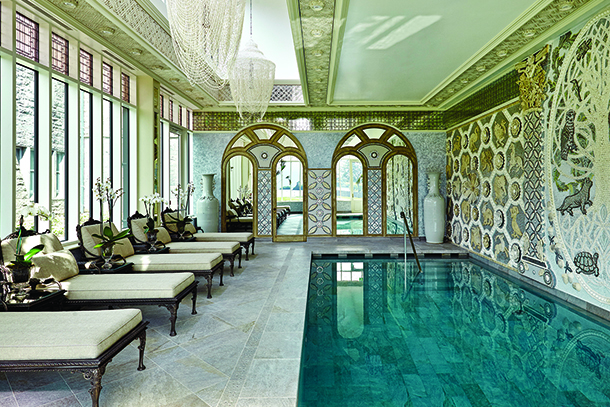
Ashford Castle
In the small village of Cong, Ashford Castle (ashfordcastle.com) is technically a few steps over the border into the neighboring county of Mayo. Cong is famous as the location of John Ford’s 1952 film The Quiet Man, starring John Wayne and Maureen O’Hara. The Quiet Man has done more than any other film to influence American perceptions of Ireland, for better or worse, and both the village and the castle have been milking its association with the movie ever since, catering to the legion of “Quiet Maniacs” delighted to find that many of the fixtures seen in the film, like Pat Cohan’s Bar, are still around.
But regardless of its cinematic connections, Ashford Castle is a destination in its own right because as an architectural gem and as a bastion of luxury and hospitality, it has few, if any, peers in Ireland. Steeped in history, Ashford Castle was first built by invading Normans in 1228—the original stones placed by the de Burgo family are still visible in the northwest corner of today’s structure. The de Burgos, soon to become known as the Burkes, were unseated by invading British forces sent by Queen Elizabeth I in 1589 and a fortified enclave was subsequently added for its use as a British fortress. Later, owners added the French château structure that is now the center part of the castle. Development of the property toward its modern profile began in earnest when it was acquired in 1852 by Sir Benjamin Lee Guinness of Irish brewery fame. Work continued by his son, Lord Ardilaun, in the ensuing decades.
That Ashford Castle still exists is something of a miracle, however. During Ireland’s fight for independence from England that began with the famed Easter Rising of 1916, many of the castles in Ireland were burned or otherwise gutted as they were seen as symbols of oppression. Why Ashford Castle was spared this fate remains a mystery, says local historian Fintan O’Gorman, who is still searching for documents that might explain its survival amid a revolution. But perhaps the castle’s links with the national beverage of choice played a role.
By 1939, Ashford had become a first-class hotel, but it wasn’t until the recently completed $50 million restoration by its current owners, Stanley and Beatrice Tollman of Red Carnation Hotel Collection fame, that Ashford Castle rediscovered its old glory and added many modern amenities. Underground tunnels were turned into wine cellars under the supervision of Head Sommelier Paul Fogerty, who has amassed a fine collection from France and elsewhere with Irish roots in their vineyards. Some bottles date to the Flight of the Earls in the early 17th century after their defeat by English forces, an event that marked the end of the old Gaelic order. Also added was a separate, modern, country-style hotel-within-a-hotel, The Lodge at Ashford Castle (thelodgeac.com). Originally built for the estate manager in the 19th century, The Lodge will be of special appeal to families and wedding parties.
Today’s Ashford Castle makes guests feel like a returning earl with 83 guest rooms furnished in Victorian style. Two of the suites are named for President Ronald Reagan and Senator Ted Kennedy, former guests along with celebrities like John Lennon and Brad Pitt as well as royals from abroad. The spa is consistently rated among the best in Ireland. A new, large billiards room with an adjacent outdoor terrace is a redoubt of relaxation, as is a new 32-seat cinema. Three restaurants offer fine dining—but an intimate evening of song, dance, food, and Irish whiskey, mixed with a dollop of blarney, at a cottage used in The Quiet Man should be on the agenda. Ashford also has 350 acres of play space that includes a nine-hole golf course, ponds for fishing, a clay pigeon shooting range, a pier for cruises of Lough Corrib, and a not-to-be-missed school of falconry where a gloved hand meets birds of prey. Guests also can join Cronin and Garvin, a pair of enormous Irish wolfhounds, for their long-legged morning walk.
But the real secret of Ashford Castle is that the hotel can make you feel like being in one of those spy camps, where arrivées take on a new “legend” or identity. It’s in casual conversation that you might first learn of popular Irish sports like hurling or put often-heard words like “brilliant” or “grand” on the tip of your tongue—the first steps toward carving English into a more expressive language that reflects the Irish temperament. Rashers, black pudding, and soda bread are added to your culinary vocabulary. The Wellies at the door are calf-high rubber boots that are the preferred footwear for navigating damp fields. A fisherman’s sweater or wool scarf from the nearby Aran Islands is probably in your future, as is an Irish-designed, lined, waterproof jacket from Jack Murphy. Rain is always in the forecast, but it’s a country where you might think umbrellas seemingly have yet to be invented; the locals know the Atlantic wind bends them into useless foreign objects.
Full immersion into the Irish way of life occurs during the various excursions into the surrounding country. The small-party trip with a local guide into Connemara is the most illuminating, if only because of the way the light shapes the mountains, valleys, and lakes of this vast, wild landscape. Stops include a visit to the lovely home of a basket maker whose weavings are works of art, and a more industrial voyage on a boat used for oyster farming in a long, isolated bay. It’s a trip that reveals the character of the Irish soul with a momentary pause at an ancient, isolated graveyard that was the last resting place of the unbaptized during the country’s more zealous days. The sharp-eyed will notice an old fairy fort nearby; the reasoning being that if the new Christian religion wouldn’t take care of these departed, the old, mythical one would. From there, you’ll learn how to pull a pint of Guinness properly (it’s a seven-minute process) at Paddy Coynes—a cozy pub in operation since 1811 in the village of Tullycross—while listening to a father-son team of musicians playing traditional Irish airs. It’s a pub so popular that the dying wish of its most loyal customer was honored; his gravestone is in the back garden.
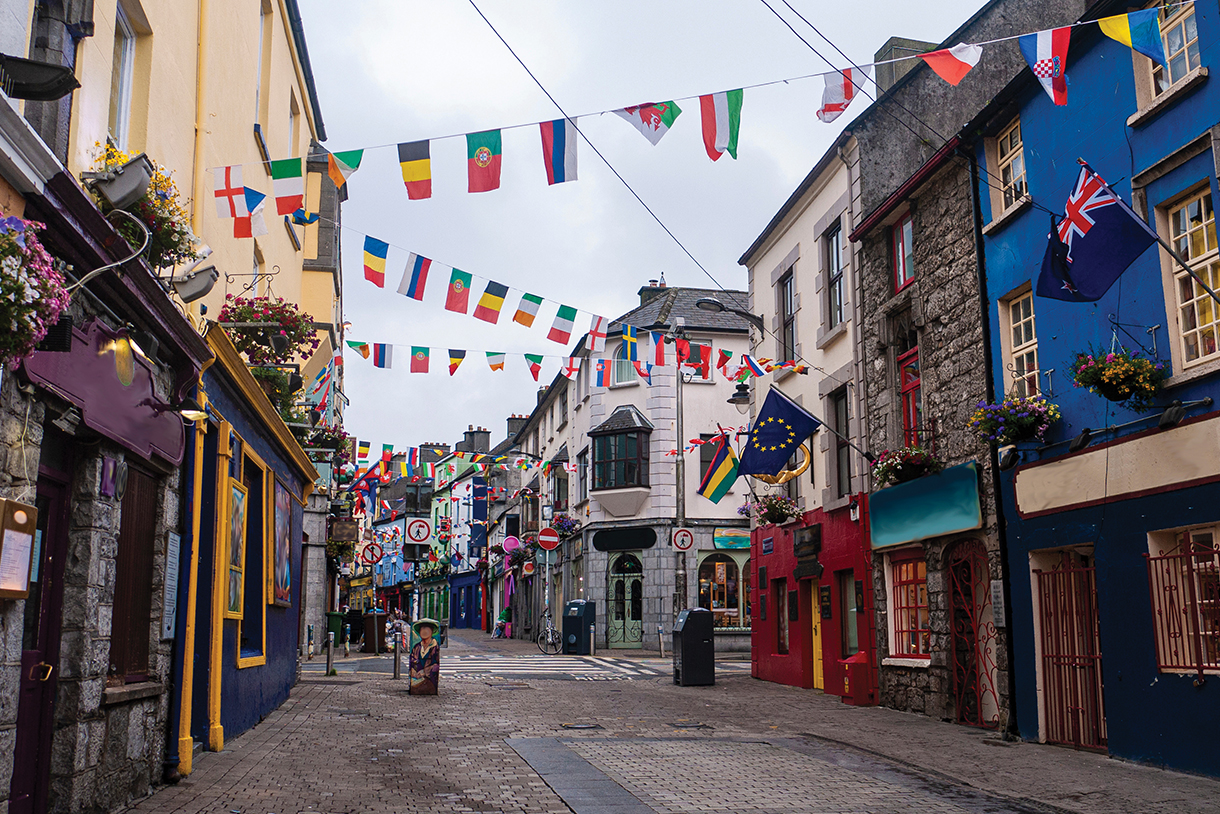
Galway
However you get to the city of Galway at the southern end of Lough Corrib and head on to the Atlantic coast, you should do it with Ed Sheeran’s “Galway Girl” in your ears, because it will make the transition easier. Music is virtually a way of life in the City of Tribes—Galwegians often refer to themselves as tribesmen, a reference to the 14 merchant families who dominated political, commercial, and social life between the 13th and 19th centuries—so don’t be surprised to find a girl playing a fiddle in an Irish band. Galway is a city of the arts known for its many festivals as well as the Galway Races (galwayraces.com), the Irish answer to the Kentucky Derby, held in August.
The best-placed luxury hotel in the city is The Galmont (thegalmont.com), a very modern edifice with 275 rooms, an award-winning spa, and a delightful restaurant that serves locally sourced food, which means plenty of fish. But its chief attribute may be its proximity to the Latin Quarter, named for the language once spoken by resident medieval scholars. The Latin Quarter is among the most beautiful parts of the city with its cobblestone streets playing host to a wide assortment of colorful shops, restaurants, and pubs with buskers performing on every corner. Don’t miss Charlie Byrne’s Bookshop (charliebyrne.ie), a Galway institution that has over 100,000 used and new titles on sale at any one time. The staff will happily direct readers to well-known Irish literary luminaries like W.B. Yeats, Seamus Heaney, and James Joyce, as well as modern bright lights like Tana French and Mike McCormack. Weavers of Ireland (weaversofireland.com) is among the many shops that offer locally made scarves, sweaters, caps, and anything else that can be made off the back of local sheep, while the boutique Hazel Mountain Chocolate (hazelmountainchocolate.com) also offers tours of its factory in the nearby Burren mountains. Claddagh Jewelers (thecladdagh.com) offers Claddagh jewelry, two hands clasped around a crowned heart. Rings worn with the heart facing inward mean the wearer’s heart is taken; conversely it signals availability. It’s a signifier that may come in handy at one of the many pubs that have nightly traditional music sessions, foremost among them these days being the red-painted Tig Coili pub where a Duke and Duchess named William and Kate recently raised a glass after “having a go” at hurling. Galway is the kind of place where you know everyone, but just haven’t been introduced yet. There are lots of little places to call your own.
Sunny days light up Galway like spotlights, so much so that shade feels like it’s in another dimension. At the bottom of the Latin Quarter, Galway meets the sea. Wander in the bright light through the Spanish Arch, built in 1584, onto The Long Walk, which is actually a short, pretty, harborside promenade. More ambitious ramblers can take the seaside path toward the beaches of Salthill, stopping at the diving tower where an ocean plunge awaits. Another option is to book passage on a Galway hooker, a single-mast, wood-keeled sailing vessel of local design easily identified by its trademark red sails. Ciaran Oliver of Galway Bay Boat Tours (galwaybaytours.com) will make you part of the crew with tales of local fairy women and ghost ships. On a good day, the stony Aran Islands (aranislands.ie) are visible in the distance. The Aran Islands are emblematic of traditional Irish life and inspired J.M Synge’s revered The Playboy of the Western World, a 1907 play that was ahead of its time in exploring the power of rumor over information. Daylong or overnight trips to each of the three islands via ferry can be booked from your hotel, but the exclusive Inis Meain Restaurant & Suites (inismeain.com), with its five suites and 16-seat dining capacity, is the most monastic in its design and remoteness.
No matter how you spend your time in Galway, you will leave slightly changed for the better. Shannon Airport is the nearest and easiest with the most regular flights via national airline Aer Lingus (aerlingus.com). “People talk about coming back to Galway before they have even left,” observed a Galwegian. They are missing it before they’ve gone.




